
The goals of the anti-abortion movement could be closer than ever or could slip away. Photo: SAUL LOEB/AFP via Getty Images
Sunday, January 22, is the 50th anniversary of the announcement of Roe v. Wade, the Supreme Court decision that acknowledged a federal constitutional right to abortion. It’s also the first Roe anniversary since the decision was flatly reversed by the Court in Dobbs v. Jackson Women’s Health Organization. And so, as The Atlantic’s Elaine Godfrey observes, the annual March for Life in Washington, D.C., is a little unfocused this year:
In recognition of that fact, the march has a new route. It will finish somewhere on First Street, between the Capitol and the Court building, an acknowledgment of the enormous and somewhat nebulous task ahead: banning or restricting abortion in all 50 states. That task will involve not only Congress, the courts, and the president but also 50 individual state legislatures, thousands of lawmakers, and all of the American communities they represent.
It’s as though Captain Ahab suddenly harpooned Moby Dick and had to figure out his next step in life.
Dobbs triggered much celebration and self-congratulation among anti-abortion activists: Their decades-long strategy of undermining Roe via Supreme Court appointments by Republican presidents had finally borne fruit. But this development was obviously just a condition precedent to the movement’s ultimate goal of banning abortion entirely and everywhere. It raised a lot of new and difficult questions about where to move next and how quickly to do so while fundamentally changing the dynamics of the abortion debate.
Since the central legal battle has now been resolved, the most urgent task for anti-abortion activists is to rethink their alliance with the Republican politicians they rely on for further progress in ending reproductive rights. Yes, there have always been considerable differences of opinion within the anti-abortion ranks over strategy, tactics, and rhetoric. But intra-movement arguments that were largely theoretical when Roe was in place are suddenly very real, and their resolution must be coordinated with GOP elected officials, candidates, and opinion leaders. There is no question that while Dobbs led quickly to abortion bans wherever they were possible, it also produced a sea change in public opinion that has to be troubling to those for whom reversing Roe was just the starting point.
The Guttmacher Institute reports that, post-Dobbs, 24 states have enacted some sort of previously unconstitutional abortion ban. But at the same time, the abortion-rights side won every 2022 ballot test on abortion policy including three in the deep-red states of Kansas, Kentucky, and Montana and another in the key battleground state of Michigan. Perhaps of equal significance, candidates from a Republican Party that had maintained a steady partnership with the anti-abortion movement since at least 1980 ran away from the issue as quickly as it could in most competitive election contests. At the federal level, Republicans hid behind the ancient and entirely insincere pre-Dobbs claim that they wanted only to return the issue to the states. (If you think of fetuses as “babies” with an inalienable “right to life,” then that’s a contemptuous dodge; today, as in the antebellum era, “states’ rights” is just a veil for more absolute policy goals, whether it’s slavery or forced birth.) And in states where voters were allowed to weigh in, Republicans sometimes shrugged and deferred to the abortion-rights majority of public opinion.
So the challenge before anti-abortion activists isn’t just to reach internal consensus over short- and long-term goals and tactics; they also need to reimpose discipline on the GOP and its shifty politicians. Fortunately for these activists, they will have a lever via their influence on what looks to be a highly competitive 2024 GOP presidential nominating contest. Republican presidential candidates will find that support for a federal abortion ban is an absolute condition for the movement’s support. At the same time, Republicans at the state and local levels will be pressed to work toward the most extreme abortion policies that are politically viable wherever they run or hold office. If Republicans candidates stick with their impulse to avoid this sensitive issue, it could be deadly for the future of the “right to life” movement.
For all the post-Dobbs excitement over “babies being saved,” the anti-abortion movement needs to quickly make ground on public opinion or increase its control of GOP candidates. If it fails to do so, it could see the reemergence of pro-choice Republican candidates and elected officials, a nearly extinct species until now but one that could command some significant grassroots support within the party along with crossover appeal. If that happens, the nation’s abortion-rights majority will impose its will sooner or later, and reproductive rights may gain recognition nearly everywhere in law, if not in the Constitution.
"lose" - Google News
January 22, 2023 at 09:00PM
https://ift.tt/FAgEK1a
The Anti-Abortion Movement Could Lose Control of the GOP - New York Magazine
"lose" - Google News
https://ift.tt/YL9VAE4 https://ift.tt/mAaWtw6
Bagikan Berita Ini














0 Response to "The Anti-Abortion Movement Could Lose Control of the GOP - New York Magazine"
Post a Comment